Canine parvovirus is a common but dangerous viral disease. It mainly affects unvaccinated puppies between the ages of 6 and 20 weeks. However, parvo in dogs may also affect adult and senior dogs who have not received their parvo vaccine or missed a booster.
What is canine parvovirus (parvo) in dogs?
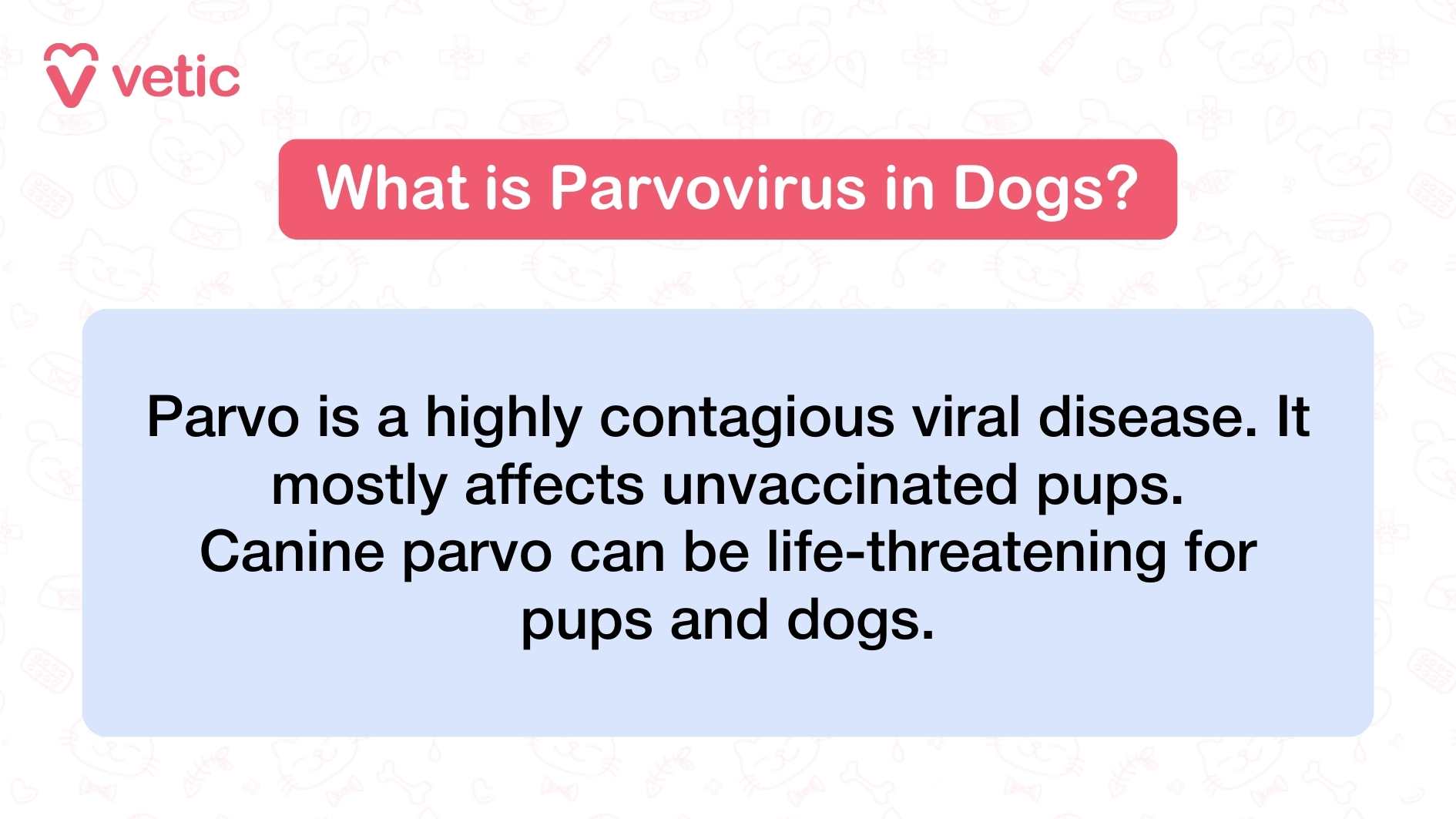
Canine parvo or parvo in dogs is a highly contagious viral disease common in unvaccinated puppies in India. The parvo virus spreads through infected poop and direct contact with infected pups and dogs.
That means if one puppy is infected in a multi-dog household, other unvaccinated puppies and dogs are also at risk. The virus can survive for days on bowls, bedding, clothes and toys.
What causes canine parvovirus disease?
Canine parvovirus or parvo is a result of the canine parvovirus type 2 (CPV) infection. Every unvaccinated dog, irrespective of their breed, is capable of becoming infected by parvo.
CPV outbreaks are still quite common. The lack of options to get puppies and dogs vaccinated during the COVID-19 pandemic caused a sudden spike in parvo cases across the globe.
The outbreaks are common and keep occurring throughout the year. So, vaccinating your dog or puppy is a must.
How do dogs get parvo?
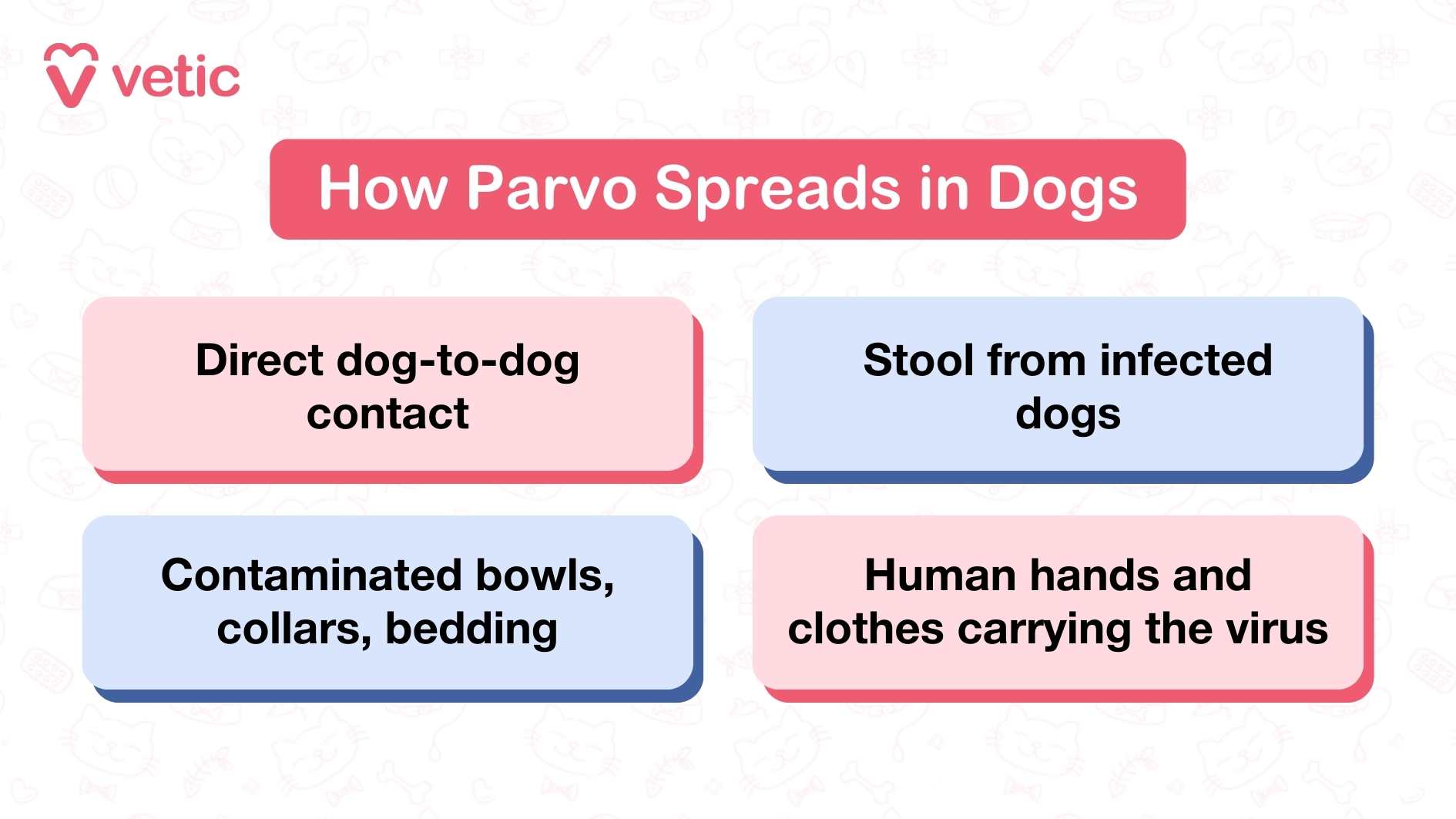
Parvo in dogs can spread via –
- Direct dog-to-dog contact
- Dog’s contact with contaminated stool
- Contaminated surfaces that contain the viruses
- People who have come in touch with infected dogs (unwashed hands and clothes)
- Contaminated food and water bowls
- Infected leashes, collars and other accessories
Thankfully, it is not an airborne virus. You have to clean the floor, furniture, furnishing, clothes, and your dog’s accessories thoroughly if they have tested positive for canine parvovirus. Cuddling or handling other dogs, after touching a CPV-positive dog can cause further spread of the disease.
Is parvo contagious to humans or other pets?
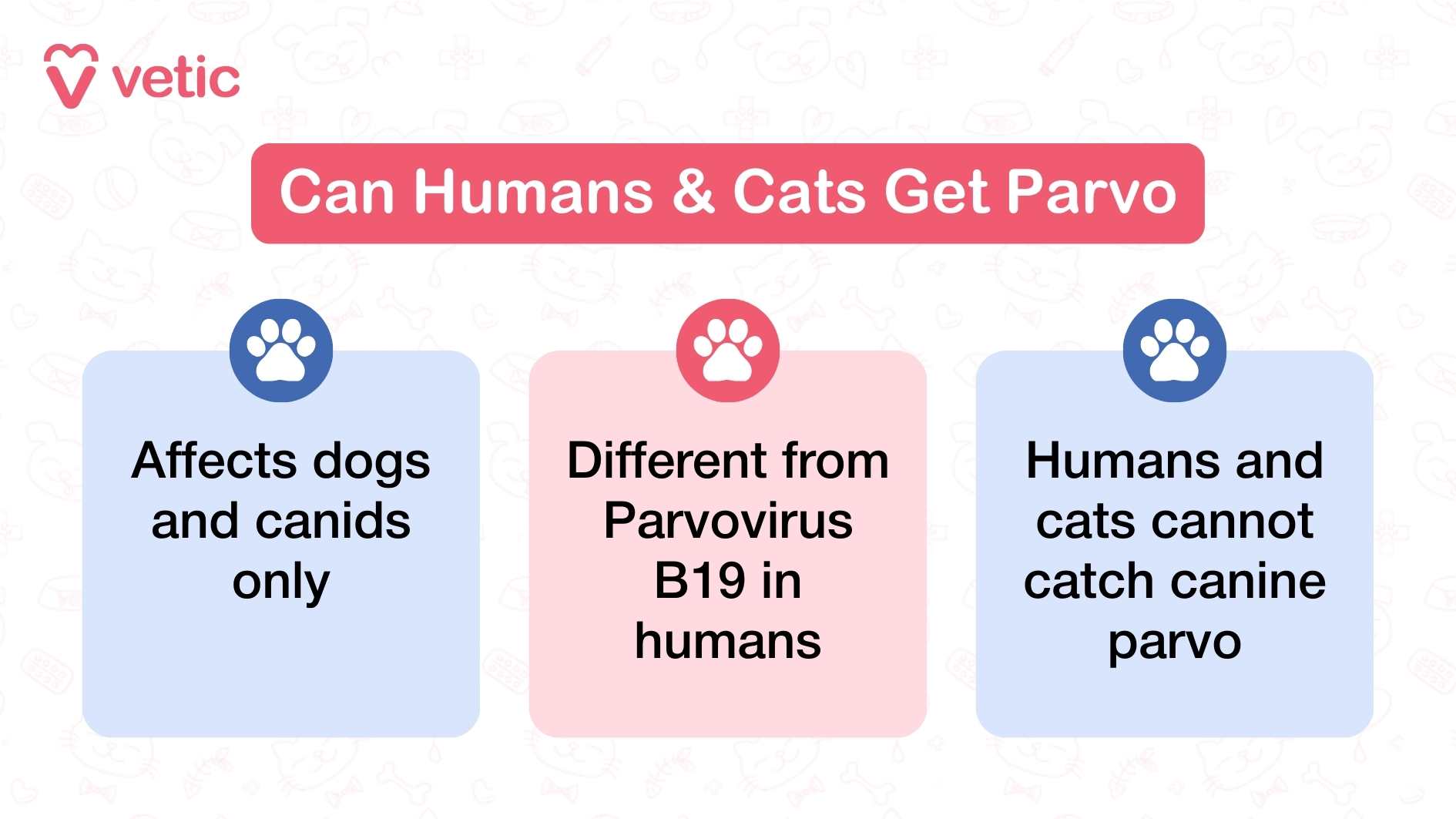
Most importantly, CPV Type 2 only affects dogs and other canids. It is completely different from the Parvovirus B19 strain that affects humans. Parvovirus B19 only infects humans and cannot be transmitted to dogs or cats.
What are the symptoms of canine parvo?
- Lethargy
- Depression
- Loss of appetite
- Nausea
- Vomiting
- Foul Smelling Diarrhoea
- Blood in stool
- Bloating
- Stomach Pain

These are the most common signs of parvo in puppies. However, the diarrhoea may not have blood in the beginning.
Parvo diarrhoea has a very distinct smell. Your pup may also be flatulent. The flatulence will have the same parvo smell. The metallic, putrid/rotten and sickly-sweet smell is often associated with parvo diarrhoea.
Fever is not a common symptom among all parvo cases. Some dogs come down with a sudden high fever after contracting parvo.
What breeds are most at risk for parvo?
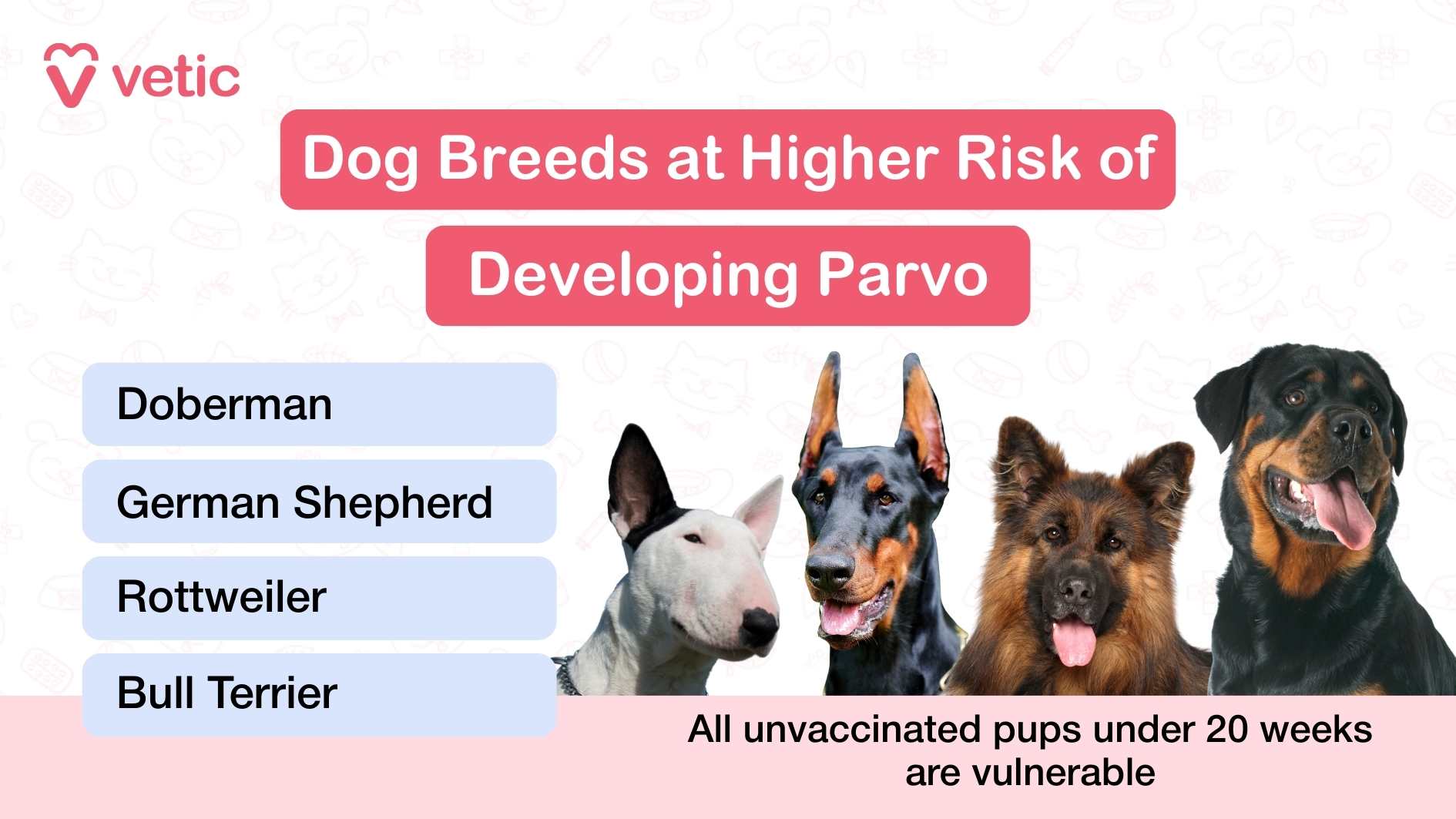
- Doberman
- German Shepherd
- Rottweiler
- Bull Terrier
These are some dog breeds at higher risk for parvo in dogs. However, all unvaccinated pups and dogs are at high risk for parvo. The biggest risk factors are age (younger than 20 weeks) and poor sanitation.
How is parvo diagnosed in dogs: Tests for canine parvovirus diagnosis
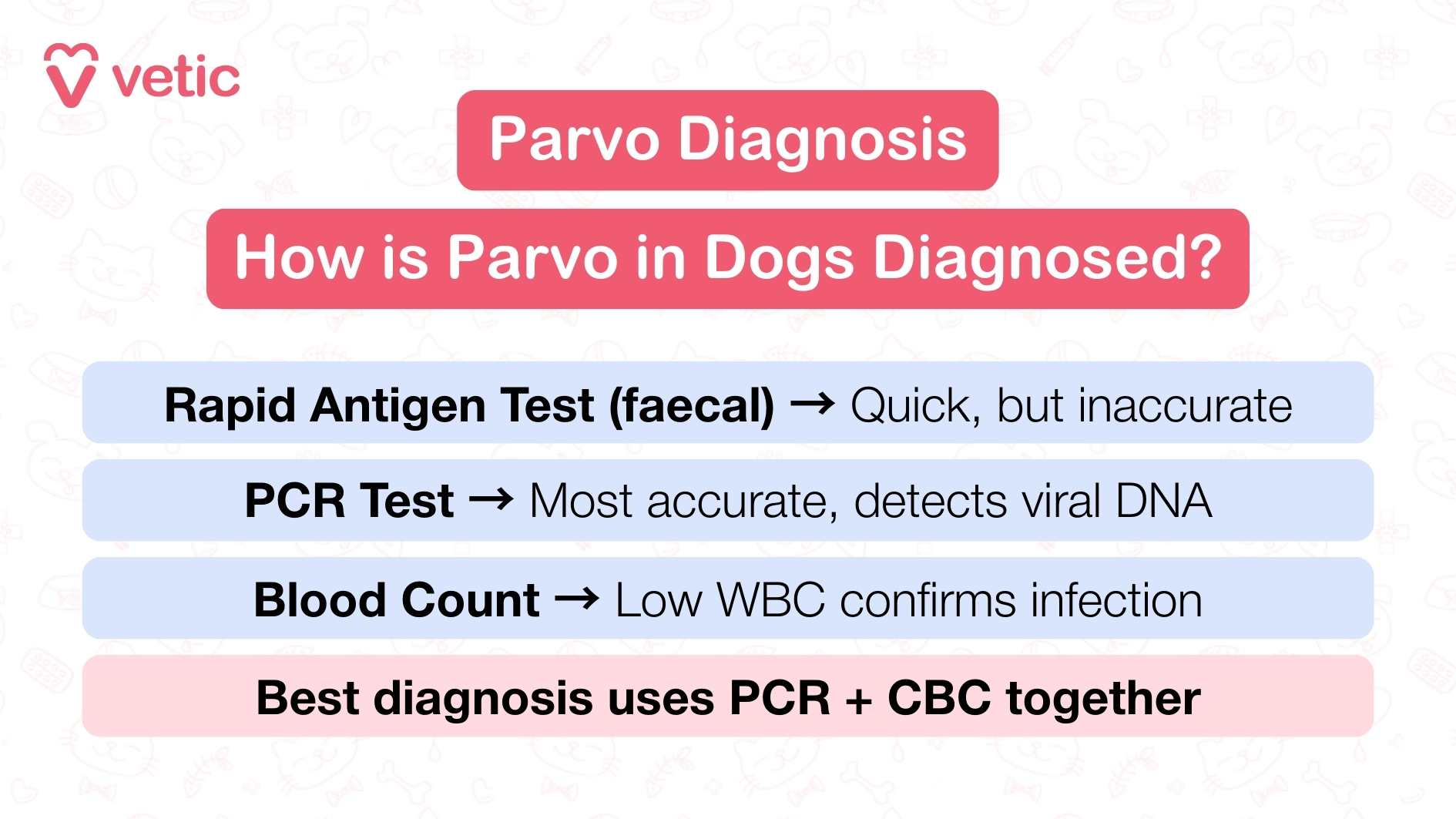
Today, most veterinary clinics have handy kits for instant parvo tests. These kits use faecal samples and rapid antigen test technology. Most of these kits are reliable. Nonetheless, they may show false negative results when your dog is not shedding the viruses through their faeces.
In such cases, the veterinarian may recommend a PCR (Polymerase Chain Reaction) test. It is more sensitive than a RAPID kit and even ELISA. PCR can detect the CPV viral particles (DNA) that are highly specific to canine parvovirus type 2.
The vet will also recommend a complete blood count. One of the biggest indicators of CPV is the sudden decrease in the level of white blood cells (leukopenia). The viruses attack the bone marrow and reduce the production of WBCs drastically.
A combination of a positive CPV faecal test on PCR and a low WBC count is often a confirmed canine parvo diagnosis.
How is parvo treated in puppies and dogs?
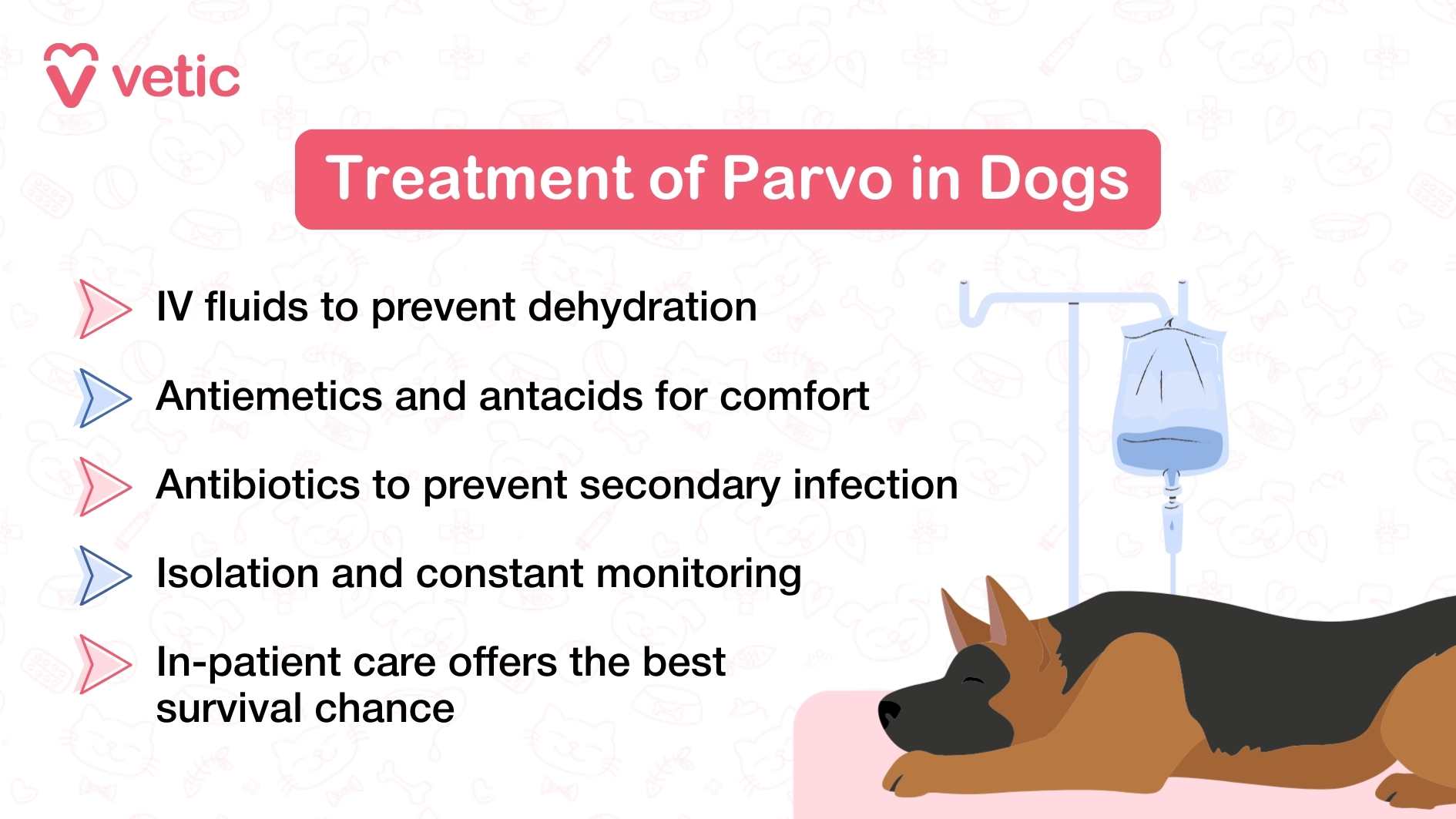
Canine parvo can be deadly if proper treatment is not provided at the right time.
There is currently no antiviral therapy that works for every dog suffering from parvo. So, parvo treatment mostly consists of supportive care, symptomatic treatment, and management of overall health.
One of the biggest challenges posed by parvo is dehydration. The first line of treatment always includes minimizing the fluid loss and rehydrating the pupper. All oral drinks and foods are stopped during treatment. So, all the fluids are given intravenously or subcutaneously, depending upon the age of the puppy.
That makes treating parvo at home quite challenging. Almost all the medication in the initial phases of the treatment should go via an intravenous, intramuscular or subcutaneous route.
Your puppy may require antiemetics and antacids to reduce their discomfort. They will also require antibiotics to minimize the chance of secondary bacterial infections.
They will need to be isolated and kept under constant observation. In-patient care with an isolation treatment area for parvo is the ideal choice for new pet parents. These places have the proper testing methods, IV fluid pumps, standard medicines and emergency medications. These facilities are typically unavailable even in the most caring homes.
Check out Vetic at Sector 45. It has 24/7 in-patient facilities with vets present around the clock. So, even if your pooch begins showing signs of parvo at 2 am, you can find all the answers at Vetic.
What is the incubation period of parvo in dogs? What happens during parvo infection?
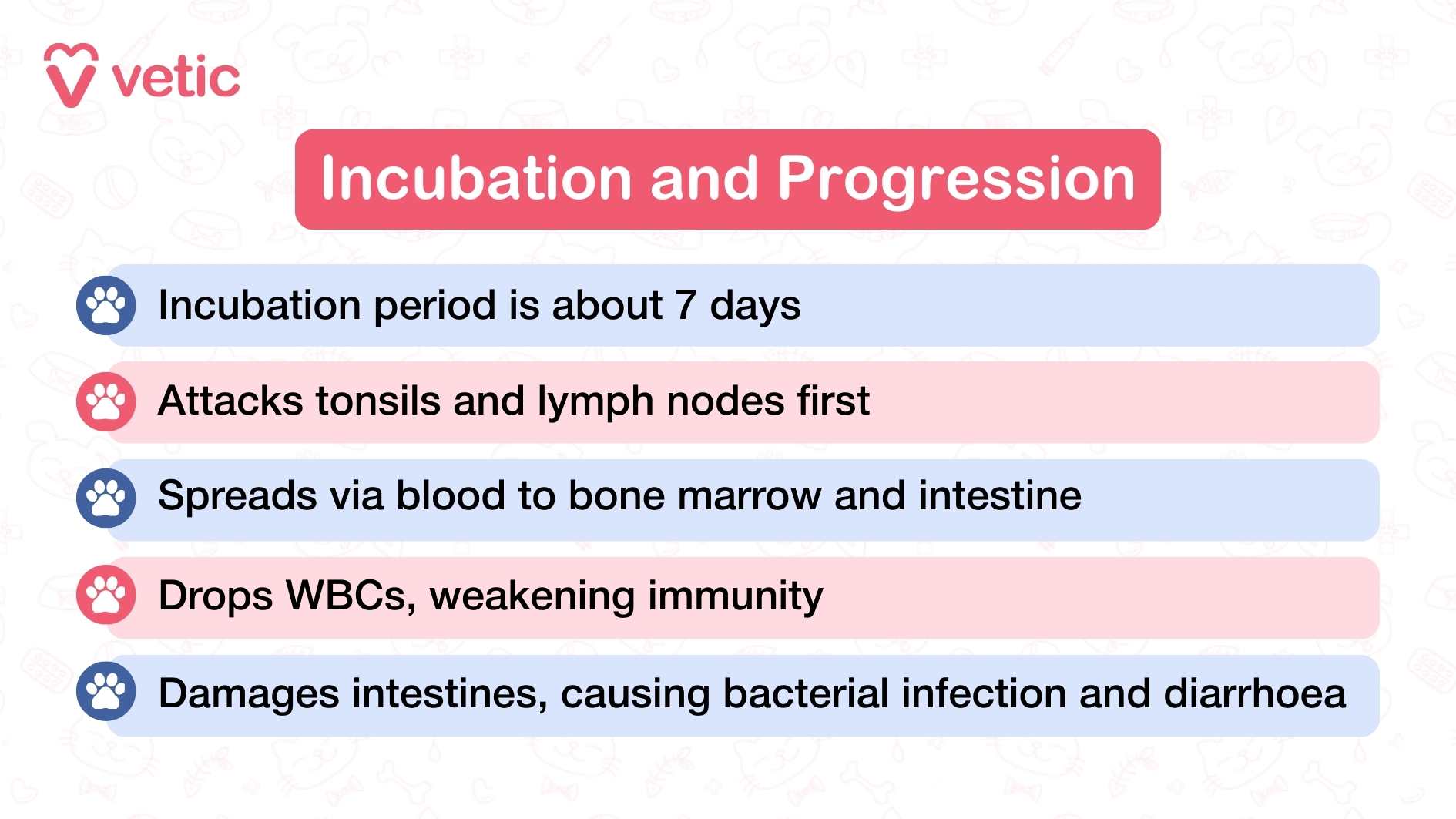
The canine parvovirus has an incubation period of about a week. So, an infected dog or puppy won’t show immediate symptoms.
The viruses require rapidly dividing cells inside the puppy’s body. Once it’s done attacking the tonsils and lymph nodes, it moves to the lymphocytes. They piggyback on the lymphocytes to spread throughout the pupper’s bloodstream.
Once in the bloodstream, the canine parvoviruses target the bone marrow and small intestine. It reduces the WBC count and causes significant gastrointestinal distress. Rapidly multiplying viral cells prevent the replacement of the cells on the small intestine wall. It leads to bacterial infections as well.
What is the lifecycle of canine parvovirus? Why is parvo in dogs dangerous?

The canine parvovirus has an incubation period of about a week. So, an infected dog or puppy won’t show immediate symptoms. The canine parvovirus can stay in a dog’s system without showing any signs for up to 7 days. It is known as the incubation period.
The viruses require rapidly dividing cells inside the puppy’s body. Once it’s done attacking the tonsils and lymph nodes, it moves to the lymphocytes. They piggyback on the lymphocytes to spread throughout the pupper’s bloodstream.
Once in the bloodstream, the canine parvoviruses target the bone marrow and small intestine. It reduces the WBC count and causes significant gastrointestinal distress. Rapidly multiplying viral cells prevent the replacement of the cells on the small intestine wall. It leads to bacterial infections as well.
That’s the main reason most infected dogs begin throwing up and pooping blood. That is also the main reason you should never give oral medicines, oral rehydration solutions and food to a dog with parvo. The intake of food and fluids will further disturb the small intestine (SI) lining and worsen the SI wall integrity.
For very young pups, CPV can also affect the heart muscles causing arrhythmias.
Canine parvovirus can become dangerous and even deadly if it’s not treated on time. To know about the standardized protocol(s) for canine parvo treatment contact or visit Vetic.
Can a dog survive parvo without treatment?
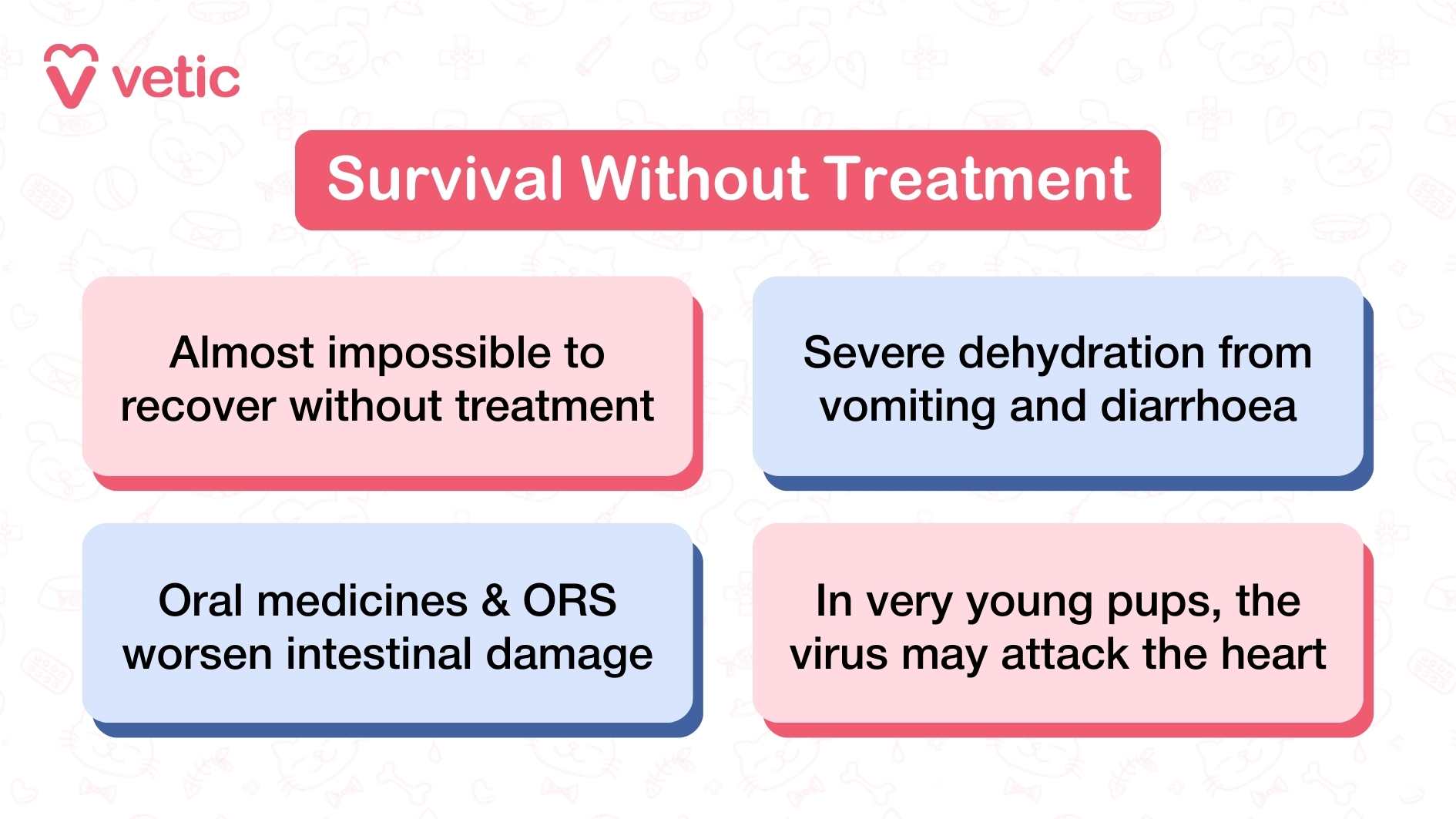
It is impossible for infected pups with parvo to survive without treatment.
That’s the main reason most infected dogs begin throwing up and pooping blood. That is also the main reason you should never give oral medicines, oral rehydration solutions and food to a dog with parvo. The intake of food and fluids will further disturb the small intestine (SI) lining and worsen the SI wall integrity.
For very young pups, CPV can also affect the heart muscles causing arrhythmias.
Canine parvovirus can become dangerous and even deadly if it’s not treated on time. To know about the standardized protocol(s) for canine parvo treatment contact or visit Vetic.
What is the recovery time for parvo in dogs?
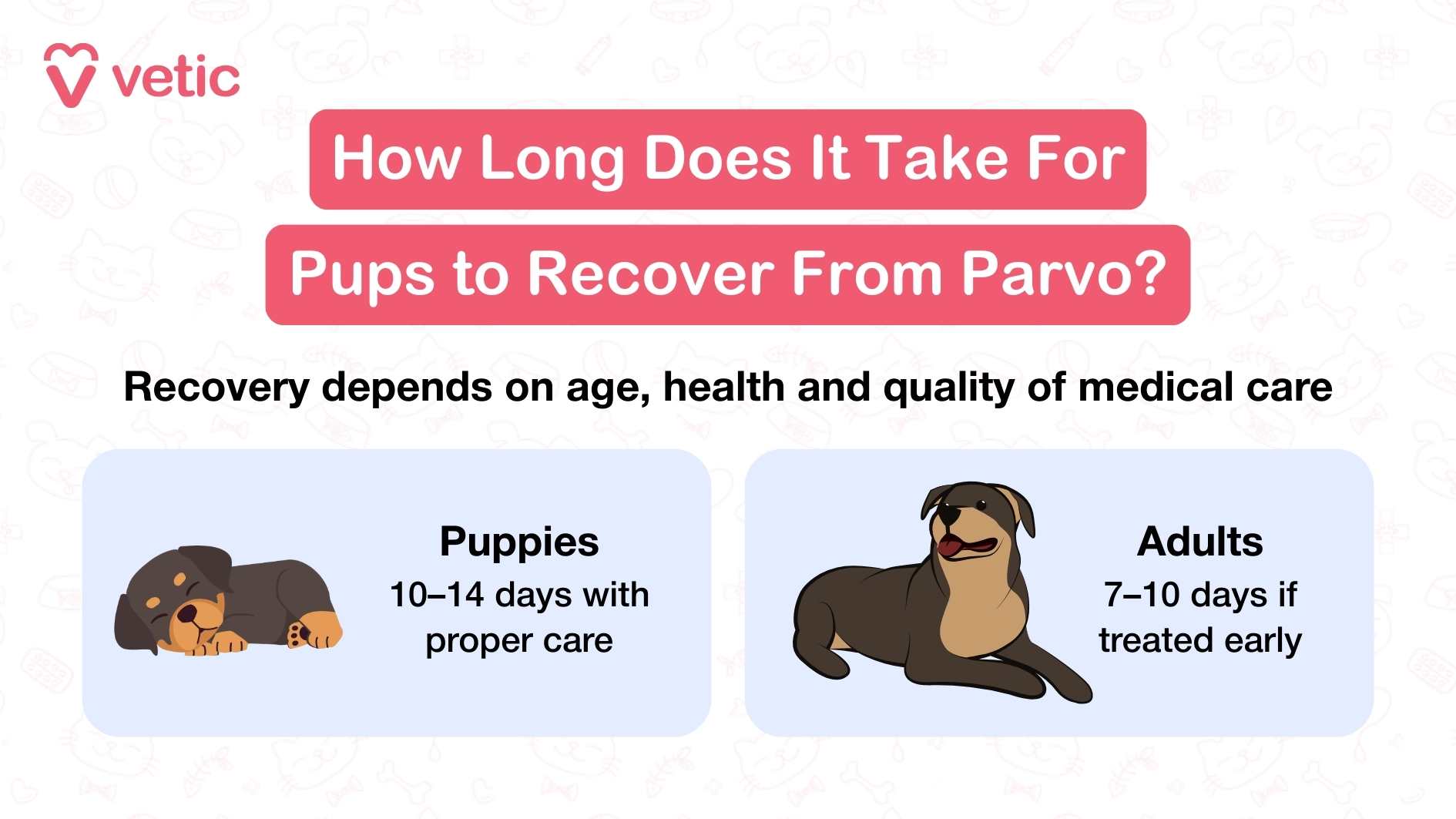
The recovery time for parvo in dogs will depend on their –
- Age
- General health
- Coexisting conditions
- Medical care & treatment
Younger pups often take longer to recover since their immune systems are underdeveloped. Even senior dogs can take longer since their immune systems can become compromised with age. The average puppy can take between 10-14 days to recover completely with proper treatment and care.
Adult dogs, whose vaccines have lapsed or remain unvaccinated, can also get parvo. The recovery time for parvo in adult dogs varies from 7 days to 10 days.
CPV Prevention Tips: How can I prevent parvo in my puppy?
Prevention of canine parvo is much easier and more economical than treating the disease.
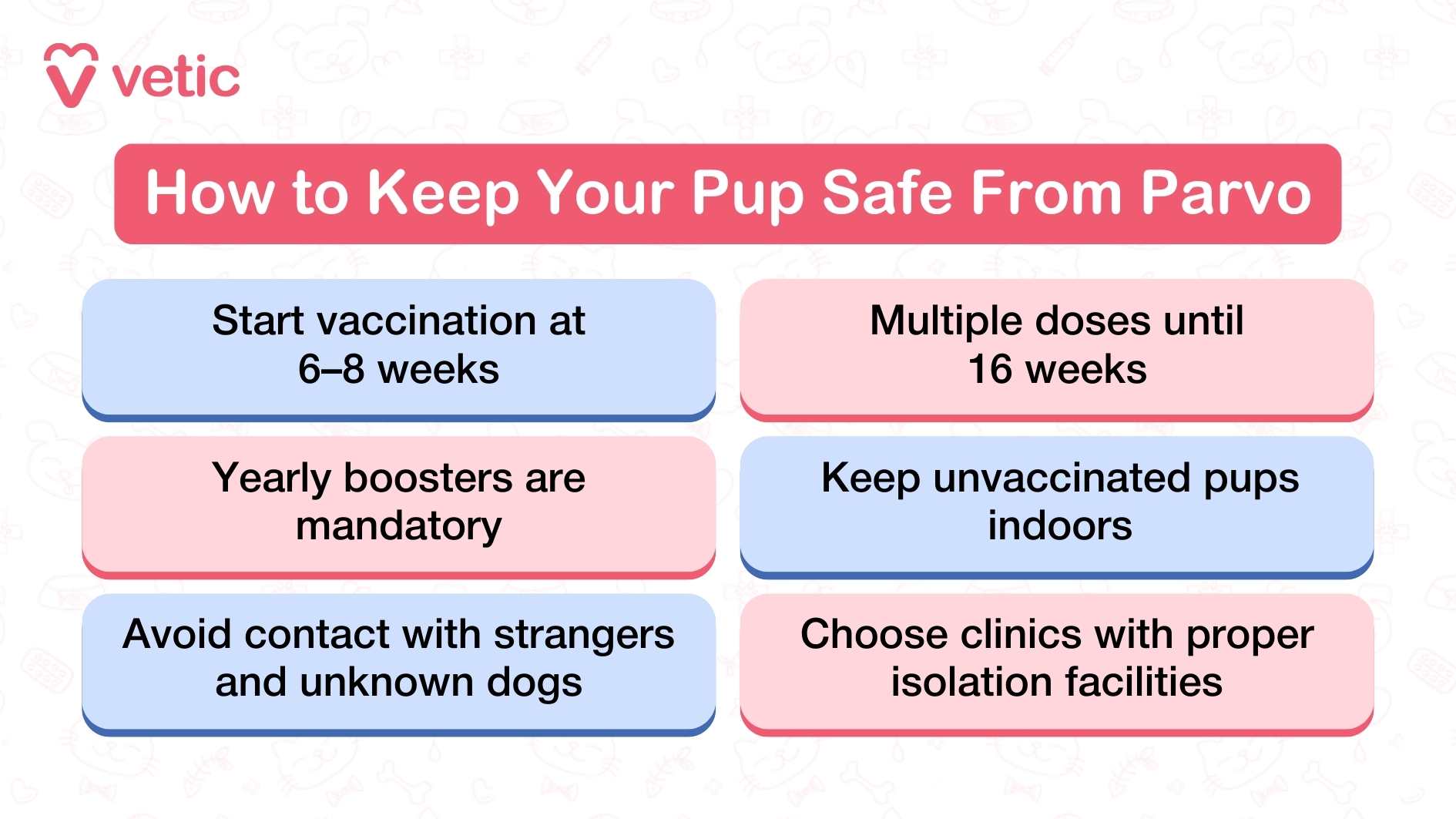
Your puppy should receive their first CPV vaccine as a part of their combination vaccine that includes canine distemper virus (CDV), canine parainfluenza type 2 virus, infectious canine hepatitis and leptospirosis. One shot is not enough to prevent these infections. Your puppy will require multiple shots up until 16 weeks of age.
Here are a few tips to protect your puppy from canine parvo –
- The only way to ensure that your puppy doesn’t contract CPV is by following the standard vaccination protocol.
- Do not forget to give yearly boosters to your dog to protect them from CPV infection.
- Do not take puppies younger than 120 days, who haven’t received their Puppy DP, DHPPiL Vaccine and booster outside.
- Do not let strangers cuddle your unvaccinated puppy.
Do not leave your puppy in any in-patient care where they do not isolate suspected CPV infections.
Never miss another vaccine or booster! Upload your pupper’s prescription and vaccine dates on the Vetic app for timely reminders. Download the Vetic App right here.
Are there natural remedies or home treatments for parvo in dogs?
We absolutely do not recommend naturopathy or home remedies for parvo in dogs. It is a potentially life-threatening disease in pups and it goes from bad to worse quickly.
You do not have the time to try home remedies and wait to see if your pup is doing better. At the same time, there is no published study of parvo being treated through natural remedies.
FAQs on Parvo in Dogs
Parvo in Dogs: India-Specific Frequently Asked Questions
1. Is parvo in dogs common in Indian cities like Kolkata, Mumbai, Delhi, Gurgaon, and Bangalore?
Yes, parvo is very common in large Indian cities due to high stray dog populations, low vaccination coverage, and densely populated urban environments where the virus can be easily transmitted. Outbreaks are regularly reported, and local clinics see frequent cases, especially during the monsoon.
2. Why are puppies in India at higher risk of parvo?
Puppies aged 6–20 weeks, especially those not vaccinated on time or those born to unvaccinated mothers, are most at risk. Cultural factors such as delayed vaccination (sometimes due to lockdowns or lack of awareness), and higher stray populations, increase the risk in Kolkata, Mumbai, Bangalore, and more.
3. How can I protect my puppy from parvo in Indian metro cities?
- Strict adherence to vaccination schedules beginning at 6–8 weeks of age and keeping booster shots up to date
- Avoiding contact with stray dogs or unvaccinated dogs in public parks or streets
- Cleaning paws thoroughly after outdoor walks (use antiseptic lotion and water, not alcohol-based sanitizers)
- Good hygiene and regular deworming are crucial.
4. Are there recent parvo outbreaks in my city?
Yes, cities like Kolkata, Mumbai and Bengaluru have reported recent parvo outbreaks, sometimes seeing dozens of fatalities in a few weeks. Causes include missed vaccinations, especially during lockdowns, and higher exposure rates for strays and owned dogs alike.
5. What are the earliest symptoms Indian pet parents should look for?
Lethargy, sudden loss of appetite, persistent vomiting, severe/possibly bloody diarrhea, abdominal pain, and dehydration. These symptoms need urgent action. Delay in seeking veterinary help often results in a poor prognosis.
6. What is the treatment protocol for parvo in Indian clinics?
Treatment usually involves:
- IV fluids for dehydration
- Antiemetics and antibiotics for control of vomiting and secondary infections
- Monoclonal antibody therapy (in advanced clinics)
- Nutritional support and probiotics for gut health
Most leading city hospitals and clinics now offer rapid antigen (SNAP), ELISA, and PCR-based diagnostics for parvo.
7. Can my vaccinated dog still get parvo?
It is rare but possible, especially if boosters are missed, maternal immunity has not waned, or a new strain is circulating. Proper, timely vaccination and annual boosters minimize risk and severity.
8. How do I disinfect my home if my dog has had parvo?
The virus is hardy and survives for months in Indian weather. Thorough disinfection using diluted bleach (not just household cleaners), washing bedding and bowls, and isolating recovered pets for several weeks is essential.
9. Are there unique risks or precautions in Indian climates?
The monsoon and humid weather can help the virus survive longer in the environment. Avoid leaving pets in areas frequented by strays, and keep gardens and walking routes clean if living in urban areas.
10. What should I do if I see parvo symptoms in stray dogs in my locality?
- Contact local municipal authorities or an animal NGO
- Avoid direct contact; do not touch or feed stray animals showing symptoms
- Publicize vaccination and awareness in local communities.
References:
American Veterinary Medical Association (AVMA). (n.d.). Canine parvovirus. Retrieved from https://www.avma.org/resources/pet-owners/petcare/canine-parvovirus
Cornell University College of Veterinary Medicine. (n.d.). Canine parvovirus. Cornell University. Retrieved from https://www.vet.cornell.edu/departments-centers-and-institutes/cornell-feline-health-center/canine-parvovirus
Merck Veterinary Manual. (n.d.). Canine parvovirus. Merck & Co., Inc. Retrieved from https://www.merckvetmanual.com/digestive-system/canine-parvovirus
World Small Animal Veterinary Association (WSAVA). (2020). Vaccination guidelines for dogs and cats. Retrieved from https://wsava.org/global-guidelines/vaccination-guidelines
Centers for Disease Control and Prevention (CDC). (2022). Parvoviruses. Retrieved from https://www.cdc.gov/parvovirus/index.html
Author Unknown. (2023, May 9). 2 pet dogs die in Lucknow from the deadly virus. The Economic Times.
Ramakrishnan, S. (2021, July 22). Chennai: Amid canine parvovirus outbreak, 5-day vaccination drive organised. Indian Express.
Sengupta, N. (2021, February 21). Pet owners in panic as ‘canine parvovirus’ enters Bengal, over 250 dogs dead. India Today.
